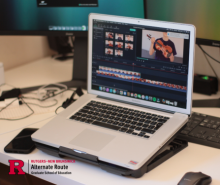5 Strategies For Avoiding Teacher Burnout This Holiday
It’s not uncommon for teachers to feel that there aren’t enough hours in the day when they are balancing heavy workloads, student assessment, lesson planning, social learning initiatives and professional development. Teaching is a demanding profession requiring high attention, social interaction and emotional involvement. If stress and fatigue are prolonged and left unchecked, daily teaching interactions quickly morph into trigger points for anger, depression and disillusionment. It’s no wonder that 8 percent of teachers are opting to leave the teaching profession well before retirement.
Halfway to the finish line, now’s the time to quickly celebrate all that your students have accomplished so far, and forget about the classroom, shifting your attention to recharging your energy, patience, and sanity.
TREAT YOURSELF
The holiday season can be an expensive time of year, but that doesn’t mean you can’t treat yourself to some well needed ‘me’ time. Whatever it is that you like to do, commit to doing it as often as you can during the break. Set up a countdown for yourself to build up your excitement for the break. Were you just dying to watch a new Netflix series this fall (weren’t we all?), or pining to go on an adventure? Let your friends and family in on the secret so that they can hold you accountable to your ‘me’ time.
WORK?—FORGET ABOUT IT
Your electronic devices won’t make it easy for you to forget about work if you, like most teachers, use your phone or personal computer/laptop for work purposes. Establish some e-boundaries for yourself this winter break. Move your teaching related apps from the home screen of your mobile or tablet devices, and from your computer desktop. If you use your phone to check work emails, turn off your email notifications. Keep reminders of work from taunting you during your break.
GET CREATIVE
Creative projects and hobbies provide a mental escape from work demands, serving as a form of self-care. Paint, draw, explore nature, write, bake, play—whatever you do, commit to being present in the moment, your moment.
This time that you carve out of your day will allow you to interact with others as a more balanced and self-aware version of yourself. Hobbies that involve group activity also provide opportunities to connect with a community of likeminded people.
BREATHE & RELIEVE STRESS
Breathing, meditation and mindfulness exercises are receiving increased attention from educators for their ability to reduce feelings of anxiety and stress. Teachers who positively channel stress and anxiety using these methods report feeling more focused, confident, objective, energized and calmer.
Free meditation apps exist for Apple and Android users. A plethora of breathing exercises and guided yoga exercises exist on YouTube. Mindfulness revolves around breathing exercises, setting intentions focusing on the present and managing expectations. It can either be incorporated into your daily activity or exercise regimen. Yoga is the gateway to mindfulness for many, given its popularity, emphasis on breathing and mindfulness and exercise component. Exercises more generally help to relieve stress by getting more oxygen pumping in the bloodstream, and increasing dopamine and endorphin levels.
RETURN TO SCHOOL WITH A NEW RESOLUTION
Oh how time flies when you’re putting your wellbeing first. You don’t have to do much to keep teacher burnout at bay during the rest of the school year. For you to emerge from each school week totally refreshed and recharged, explore how you stress-relief practices downtime can be incorporated into your day. Perhaps a 5-minute meditation or moment outside is enough to re-energize yourself. What works for you may not work for others, but after focusing on recentering yourself this winter break you should have a clear sense of your preferences.
Commit wholly to replacing all of your stress and anxiety-inducing, old habits with healthier, new ones. Don’t be afraid to continue setting boundaries for your personal and work life. Your need for downtime is not a sign of weakness, or reason for guilt. Spend some time re-evaluating your time commitments when school’s back in session and seriously consider whether you need to ask for help in school or at home. Are you managing your expectations when you leave the classroom and bringing a realistic amounts of work home with you in the evenings? Remember there will always be work for you to catch up on—a teacher’s work is never done. Give yourself a time limit for your home work that allows you to enjoy dinner, unwind and rejuvenate yourself. Ultimately, your health and wellbeing are irreplaceable.
FINAL THOUGHTS
The time you spend outside of the classroom is as influential on student learning as the time spent in the classroom. The next time you feel yourself being overextended, face your feelings of burnout head-on and repeat the above process of finding a healthier, happier point of balance. Allow the threat of teacher burnout to keep you in tune with your personal enrichment needs. Consider turning to your peers, mentors and Alternate Route community for support and advice. Every teacher has happy, proud, difficult, overwhelming or even anxiety-inducing moments. Share yours with your peers—don’t allow your feelings to balloon without release and extinguish your spark for teaching. Chances are there are others who can relate to your situation, help you unpack your experiences, and provide meaningful advice and encouragement. Keeping your work in perspective with the bigger picture and feeling connected to a community of teachers, you’ll find that it’s easier to stay motivated and energized.

 Heather Ngoma has over 25 years of experience collaborating with educators across New Jersey to drive education innovation. She currently serves as the Director of the Rutgers-GSE Alternate Route Program in the Department of Learning and Teaching, a program which helps career changers, recent college graduates, and other aspiring education professionals become licensed teachers in New Jersey. Follow her on Twitter @heatherngoma.
Heather Ngoma has over 25 years of experience collaborating with educators across New Jersey to drive education innovation. She currently serves as the Director of the Rutgers-GSE Alternate Route Program in the Department of Learning and Teaching, a program which helps career changers, recent college graduates, and other aspiring education professionals become licensed teachers in New Jersey. Follow her on Twitter @heatherngoma.





